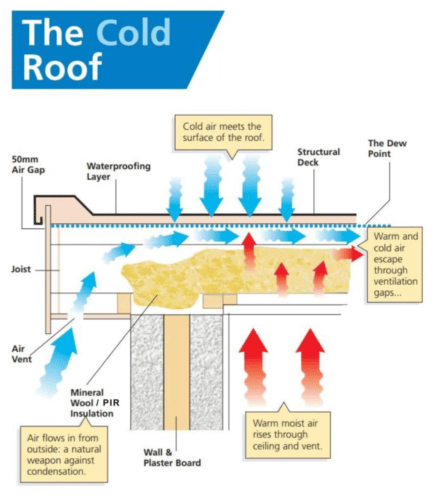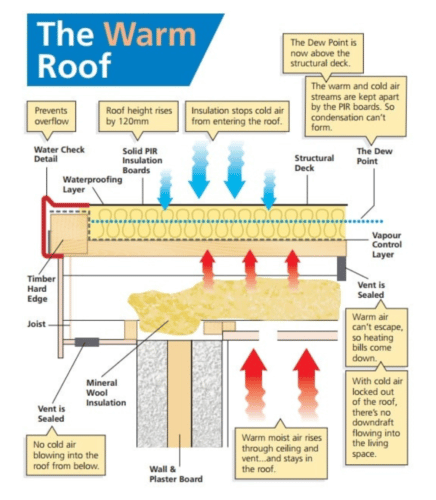Improving insulation and the energy efficiency of our homes has become a huge topic of conversation in the last few years due to soaring energy costs. So it makes sense to do the best we can to “future proof” our homes especially focusing on home improvements related to roofs and flat roofs. Since about 25% of heat escapes through a roof, insulating your flat roof becomes a crucial step towards enhancing your home.
Flat roof replacement is a big decision. You may be struggling with damage, decay, natural deterioration or just want a pristine look for your flat roof. Whatever the reason, it’s important that you make the right choice and don’t feel pressured when making your decision.
Gone are the days when mineral felt was the only option for your flat roof. In recent years, we’ve seen big innovations in the flat roof industry that benefit homeowners and commercial property owners.
Unfortunately, it also makes the decision-making a little trickier because insulating your flat roof is now a requirement under the new building regulations, as there are now a few different types of flat roofing insulation to consider. For many people, the most significant decision to make is whether to replace their cold roof with a warm roof.
But what’s the difference?
Here’s what you need to know to make an informed decision about insulating your flat roof properly…
What Is A Cold Roof?
Cold roofs emerged due to changes in building standards. In the pre-war era, houses were built for sturdiness, but materials and building methods used didn’t account for interstitial condensation issues. As a result, these houses often experienced condensation problems once modern heating systems were fitted.
After the post-war housing boom, new insulation regulations required minimal insulation in roof spaces. Combining this with old, rot-prone materials and warm vapours from ceilings created a ticking time bomb.
In the 80s, the ‘cold roof’ was developed to address this issue. Roofers added ventilation to let cold air in and “dry out” interstitial condensation. However, this method wasn’t very effective. Ventilation couldn’t eliminate all moist air, leading to efficiency issues. Additionally, ventilation holes allowed heat to escape, making it harder to heat homes.
That’s when the warm roof solution was introduced.
What Is A Warm Roof?
A warm roof has now become the premium standard for homeowners who want to completely forget about roof maintenance for good and know that it will stand the test of time.
A warm roof features solid PIR (Polyisocyanurate) insulation boards attached above the roof deck, protected by moisture-resistant materials.
Additionally, sealing all ventilation points above and below the roof deck stops cold air from circulating through your roof.
Together, these major changes create a warm roof space with a changed ‘dew point’ positioning. This means the condensation point has moved outside of your roof space, so the mix of cold and hot air that creates moisture is now above the roof deck.
And hey presto, your roof is no longer at risk of becoming brittle, rotten or a disaster waiting to happen.
How It Works
If you’re still unsure how a warm roof works – and how it’s any different from a cold roof, then let’s start with the key differences between them.
Cold Roof
- Insulation between joists where ceiling vapours are present
- Ventilation gaps in your roof space allow in cold outside air
- Heat loss through your roof

Warm Roof
- Specialist insulation boards attached to the roof deck (very top of the flat roof) to prevent condensation in your roof space
- No ventilation gaps so your roof space stays warm
- Better thermal insulation in your roof
In short, a warm roof uses insulation boards attached above the roof line rather than in between the joists. This provides better thermal protection, eliminates the risk of condensation and the associated problems and is quick and easy to install.

Benefits Of Replacing A Cold Roof With A Warm Roof
There was a time when cold roofs were considered an imperfect solution to an inevitable issue. However, we now know that warm roofing can effectively address condensation and heat leakage in flat roofs.
As a homeowner, the main advantage you’ll enjoy is lower energy bills. Without cold bridging through joists exposed to cold air, your home stays warmer longer, saving you money on heating.
Additionally, upgrading to a warm roof eliminates concerns about rot and deterioration caused by interstitial condensation. Your flat roof will be long-lasting, visually appealing and provide reliable protection.
Drawbacks Of Keeping A Cold Roof
It can be tempting to just leave your old cold roof, even if it’s showing signs of age, sagging or creating damp in your roof space. You may not want to deal with the disruption of having your flat roof replaced, but it’s possible your roof can’t wait any longer.
Leaving a damaged cold roof means you’re at risk of the materials becoming wet from vapour and therefore quickly rotting. Your roof will sag in places and eventually the sagging will become so bad that your roof may fall in with the joists and decking no longer able to support their weight.
Safe to say, it’s better to spend the time now to replace your cold roof with a warm roof so that you can save stress and money further down the line.
Which Should You Choose?
Which is better, a cold roof or a warm roof? In modern roofing, a warm roof has many more benefits than a cold roof, but every property is different. Hopefully, now you feel you have the insight needed to make the right decision for your own home.
However, if you’re still unsure, just take a look at how we go about insulating a flat roof here and request your free guide to choosing the right flat roofing system here and make the best choice for your roof.
Your Next Steps to finding out what how to insulate your flat roof
After your survey, you’ll receive a free 23-point Roof Condition Report, Action Plan, and comprehensive itemised Quote worth £295+vat.

